D-Day Anniversary a Time to Reflect on the Unknowns
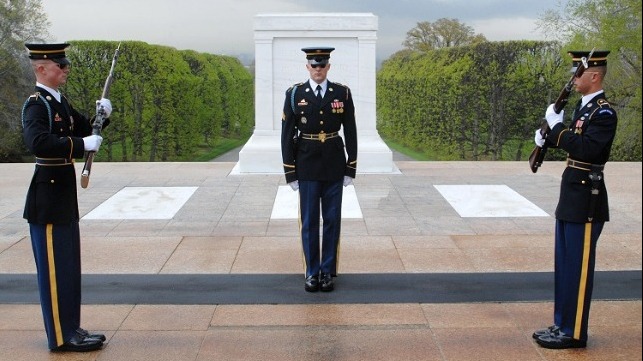
In commemoration of D-Day, June 6, 1944, MarEx honors the Society of The Honor Guard, Tomb of the Unknown Soldier, a non-profit organization committed to making certain that the individuals that made the ultimate sacrifice of their life for the nation's freedom are not forgotten.
The society has documented the history behind the unknown soldier from World War II entombed at Arlington National Cemetery in the U.S. It is reproduced, in part, here:
World War II
Starting with the Blitzkrieg upon Poland in 1939, the Axis powers, led by Germany and Adolf Hitler, began offensives throughout Europe. Eventually, most of Europe was occupied by Germany including France, with only Russia and England remaining. Japan, interested in domination of the Far East, aligned with Germany in this effort. While this occurred, the United States of America (U.S.) stood off to the side. World War II (WWII) officially began for the U.S. in 1941 after the bombing of Pearl Harbor by Japan. The next day, the U.S. declared war on the Axis powers. This would be a two front war, posing a serious challenge.
European Theater
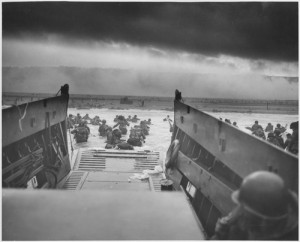 Soon the U.S. invaded North Africa, jumped into Sicily and Anzio, pushed onto Rome and the soft underbelly of Europe. On June 6, 1944, Operation Overlord (D-Day) began with assaults by air and on beaches. Once a foothold was gained on the beaches, the Allies continued to push inland, eventually liberating Paris in August of 1944. This was followed by a massive airborne invasion of Holland in September 1944. Despite many fierce battles won by both sides, the Allied countries, mainly made up of the U.S., Great Britain, and Russia pushed Germany back into their homeland and it was there the atrocities Hitler committed against millions of people in the concentration camps (Holocaust) were discovered. The capture of Hitler ended with his suicide outside the "Fuhrer Bunker" in Berlin, and the surrender of Germany on May 7, 1945 1.
Soon the U.S. invaded North Africa, jumped into Sicily and Anzio, pushed onto Rome and the soft underbelly of Europe. On June 6, 1944, Operation Overlord (D-Day) began with assaults by air and on beaches. Once a foothold was gained on the beaches, the Allies continued to push inland, eventually liberating Paris in August of 1944. This was followed by a massive airborne invasion of Holland in September 1944. Despite many fierce battles won by both sides, the Allied countries, mainly made up of the U.S., Great Britain, and Russia pushed Germany back into their homeland and it was there the atrocities Hitler committed against millions of people in the concentration camps (Holocaust) were discovered. The capture of Hitler ended with his suicide outside the "Fuhrer Bunker" in Berlin, and the surrender of Germany on May 7, 1945 1.
Pacific Theater
After the attack on Pearl Harbor, the Japanese quickly sought to take Midway, Guam and Wake Island. The U.S. Navy had to quickly get the fleet back into the fight, and aircraft carriers became one of the key weapons. There were many famous battles during this campaign. The U.S. launched the "Doolittle Raid" on the Japanese homeland helping the morale of the troops and the nation, by launching bombers for the first time in history from the deck of carriers. Other battles at Midway Island, Guadalcanal, Wake, the Philippine islands, and Iwo Jima would show the world the determination of the U.S.
On August 6 and 9, 1945, the U.S., ordered by President Harry S. Truman, dropped atomic bombs on Hiroshima and Nagasaki, Japan. WWII finally came to an end with the unconditional surrender of Japan on the deck of the battleship USS MISSOURI. While war with Japan had ended on August 15, 1945, Victory over Japan Day (V-J Day) is celebrated on September 2, when the surrender document was signed in Tokyo Bay.
Following the war, there was growing interest in having an unknown soldier from WWII laid to rest at Arlington National Cemetery (ANC). On September 6, 1945, a bill providing for the interment in (ANC) of a WWII unknown was introduced in Congress by the Honorable Melvin Price of Illinois. The measure was approved in June 1946 as Public Law 429, 79th Congress. It directed the Secretary of War to return a WWII unknown soldier from overseas and to arrange for his burial with appropriate ceremonies near or beside the WWI Unknown Soldier buried in ANC. The original date set for the interment was Memorial Day, May 30, 1951.
On November 10, 1950, after the outbreak of hostilities in Korea, President Truman approved the recommendation that the interment of the WWII unknown soldier be postponed until it appeared advisable to revive the matter. This did not take place until after the Korean War came to an end in 1953 and now that war was over, the U.S. decided to select and bury an unknown from both WWII and the Korean War.
Since WWII was primarily fought in two theaters, there needed to be a selection of candidates from both theaters. The unknown candidate from the Pacific Theater (Trans-Pacific) would be selected at Hickam Air Force Base in Hawaii, while the unknown candidate from the European Theater (Trans-Atlantic) would be selected at Epinal American Cemetery and Memorial in France. After each selection was made, the final selection would be made off the U.S. coast.
Final Selection
The U.S. Navy was given the responsibility of selecting one of the two unknown candidates. Once the two candidates had been selected, they were transported to a location off the east coast of the U.S. for the final selection ceremony aboard the USS CANBERRA. By this time, the Korean War Unknown had been selected and joined both WWII candidates. The ceremony took place on May 26, 1958. One by one, the three teams of pallbearers, their steps in time to the measured cadence of Chopin's "Funeral March," carried the three caskets up to the rain-swept ceremonial area on the after-lower-missile deck. Each team of pallbearers was guarded by a U.S. Marine, with rifles carried at port arms.
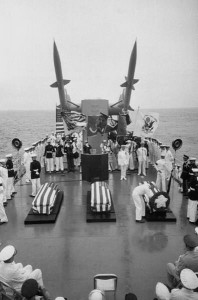 With the sky-pointed Terrier missiles as backdrops, the caskets were placed in a row with the WWII unknown candidates on either side of the Korean War Unknown. Behind them, the U.S. Armed Forces Color Guard team strained to keep their colors erect against the wind. On either side of the USS CANBERRA rode the attending ships, the U.S. Coast Guard Cutter INGHAM rolling gently at starboard and the USS BLANDY to port.
With the sky-pointed Terrier missiles as backdrops, the caskets were placed in a row with the WWII unknown candidates on either side of the Korean War Unknown. Behind them, the U.S. Armed Forces Color Guard team strained to keep their colors erect against the wind. On either side of the USS CANBERRA rode the attending ships, the U.S. Coast Guard Cutter INGHAM rolling gently at starboard and the USS BLANDY to port.
Hospital Corpsman First Class William R. Charette, the U.S. Navy's only active duty recipient of the Medal of Honor (for actions during the Korean War), was designated to make the final selection of the WWII unknown. To the soft roll of drums, HM1 Charette marched briskly to the foot of the caskets, picked up the selection wreath of carnation, a white star in a red field, faced the caskets, saluted, and returned to the head of the biers. For a short time he stood silent, looking first to the left and then to the right. HM1 Charette, after first moving to the left, turned and walked to the casket on his right, placed the wreath carefully at the head, stepped back and saluted. With the final selection made, the caskets of the WWII and Korean War Unknowns were transferred back onto the USS BLANDY.
Funeral
With the final selection completed, the WWII and Korean War Unknowns then began the final journey to ANC. For the lying in state ceremony at the U.S. Capitol, the architect who had provided the catafalque for President Abraham Lincoln also designed an identical second catafalque. The two crypts at the Tomb also had been completed. Plans for the interment ceremonies been completed in early May 1958, and between May 12 and 23, every ceremony and every administrative function had been rehearsed at least twice. Some phases, such as traffic and parking control, were rehearsed four times.
 On May 27, 1958, at 12:35 P.M., the USS BLANDY arrived at the Naval Gun Factory. The caskets, accompanied by a joint honor guard, then were brought from below to the fantail ceremonial area in preparation for the reception ceremony the next day.
On May 27, 1958, at 12:35 P.M., the USS BLANDY arrived at the Naval Gun Factory. The caskets, accompanied by a joint honor guard, then were brought from below to the fantail ceremonial area in preparation for the reception ceremony the next day.
On May 28, 1958 troops and officials began to take stations for the ceremony. Aboard the USS BLANDY, sailors and officers manned the rail. At 9:25 A.M., as the U.S. Navy Band concluded the hymns, the two groups of pallbearers boarded the ship to transfer the caskets. Once in position, the band sounded four ruffles and flourishes, and then played hymns as the caskets were borne from the USS BLANDY. The WWII Unknown was taken ashore first. The caskets were carried to funeral coaches at the end of the pier and placed inside simultaneously. Following another salute, the procession departed.
The procession then moved up to the East Plaza of the U.S. Capitol. The pallbearers and color guard preceded the cortege to the Capitol, under separate police escort in order to arrive in time to meet the procession.
A joint honor cordon formed a corridor up the east steps to the Capitol rotunda. Inside the rotunda, standing six deep in a semicircle around the south end were many distinguished guests. The two catafalques were in the center of the rotunda.
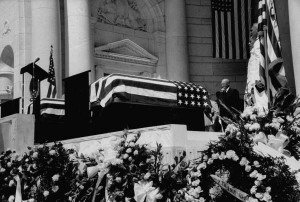 As a hymn was played, the pallbearers removed the caskets from the funeral coaches and formed a column led by the clergy, with the WWII Unknown in front. The procession passed through the joint honor cordon at a slow cadence, and when it entered the rotunda divided to the right and left.
As a hymn was played, the pallbearers removed the caskets from the funeral coaches and formed a column led by the clergy, with the WWII Unknown in front. The procession passed through the joint honor cordon at a slow cadence, and when it entered the rotunda divided to the right and left.
The pallbearers made a semicircle to the rotunda's far side then turned back to the catafalques in the center of the hall. The caskets were then placed on the biers and the pallbearers were dismissed. A Joint Guard of Honor (Death Watch) was then posted.
U.S. Vice President Richard Nixon, as President of the Senate, placed a wreath at the head of the biers. Following him, the Speaker of the House, Sam Rayburn, and the Dean of the Diplomatic Corps, Dr. Guillermo Sevilla-Sacasa of Nicaragua, placed wreaths. Shortly after the wreath-laying ceremony ended, the public was admitted to the rotunda.
Interment
On May 30, the troops involved in the ceremonies started very early. Some 250 officers and men were to occupy fifty-one posts to cope with the 14,000 cars expected along the route and in ANC. The soldiers of the 3rd US Infantry Regiment (Old Guard), who were to man rope and security cordons, also arrived early. Part of them formed a cordon around the Memorial Amphitheater to keep the ceremonial area clear and later to direct movement from the amphitheater to the Tomb. Others manned a rope cordon along Roosevelt Drive, the route of the procession. In all, troops manned about six miles of rope.
Medical aid was available during all phases of the ceremonies, due to the extreme heat. Four aid stations were set up, each staffed by a medical officer, nurse, and attendant and each equipped with supplies and an ambulance. Medics, in sedans, were to follow the procession to ANC to pick up and treat anyone who became ill in the ranks.
At 12:59 P.M., the U.S. Naval School of Music Band sounded attention. The pallbearers took up the caskets and, with the WWII Unknown leading, moved out of the rotunda. At the same moment, the saluting battery on the Washington Monument grounds began firing minute guns. The firing continued until the close of ceremonies at the cemetery except for a pause during two minutes of silence observed at the Memorial Amphitheater. The cease-fire signal for the minute guns was the firing of the first round of the final 21-gun salute at ANC.
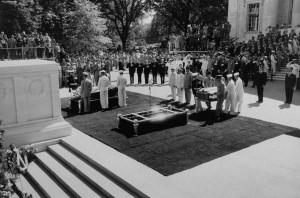 The procession halted at the top of the steps while the U.S. Navy Band sounded four ruffles and flourishes and then began a hymn. During the hymn the procession descended the steps and the caskets were secured to the caissons.
The procession halted at the top of the steps while the U.S. Navy Band sounded four ruffles and flourishes and then began a hymn. During the hymn the procession descended the steps and the caskets were secured to the caissons.
The Joint Armed Forces Color Guard took post ten paces ahead of the clergy, while the pallbearers stationed themselves three on each side of each caisson. The cortege then moved north from the plaza to join the escort of the procession on Constitution Avenue.
The full procession started toward ANC a few minutes after 1:00 P.M. Along the route was a joint honor cordon. When the procession arrived at ANC, the caissons, which had been moving abreast, shifted into a column led by the caisson bearing the WWII Unknown. As the caissons entered ANC through Memorial Gate, twenty jet fighters and bombers passed overhead with one plane missing from each formation.
After the audience was seated, the U.S. Army Band (Pershing's Own), played four ruffles and flourishes, followed by a hymn. During the hymn the pallbearers removed the caskets from the caissons and, led as before by clergy and colors, carried them inside. The WWII Unknown was borne through the south entrance and the Korean War Unknown through the entrance on the north. Just inside the Memorial Amphitheater, each casket was set on a movable bier and wheeled around the colonnade to the apse, where the WWII Unknown was placed in front of President Dwight D. Eisenhower and the Korean War Unknown in front of Vice President Nixon.
After the caskets were situated, the Marine Band played the U.S. National Anthem. Following the invocation, a bugler sounded attention three times and a two-minute period of silence followed. President Eisenhower then arose and placed a Medal of Honor on each casket. As the funeral service was brought to a close, the Unknowns were taken to the Memorial Amphitheater Trophy Room. The Presidential party also withdrew to the Trophy Room, while the audience made its way to the Tomb Plaza for the committal.
There the procession halted while the Pershing's Own sounded four ruffles and flourishes. After this salute the procession descended the steps, and the pallbearers placed the caskets over the crypts. They then took hold of the U.S. flags that had draped the caskets and held them taut above the caskets.
The salute battery, from the Old Guard, then fired twenty-one guns. At the first round, the minute-gun battery on the Washington Monument grounds ceased firing. After the gun salute a firing party from the Old Guard fired the traditional three volleys followed by the rendering of Taps. The pallbearers then folded the U.S. flags and presented them to the President and Vice President, who in turn gave them to the ANC officials for safekeeping 1. The presentation of the U.S. flags ended the committal. After the participants had left the Tomb Plaza, the public was allowed to file by the crypts and pay their respects. Later in the evening, ANC Superintendent John C. "Jack" Metzler and his assistant, F. A. Lockwood, lowered the caskets. The pallbearers stood behind a guide chain and saluted as the caskets were lowered into their respective crypts.
The final act, not part of any planned ceremony, took place on June 2, 1958. On that date, each crypt was filled with a concrete slab and topped with white marble. The marble tops bore only dates: 1941-1945 for the WWII Unknown, and 1950-1953 for the Korean War Unknown. At the same time, the dates 1917-1918 for the WWI Unknown were carved in the pavement in front of the Tomb.
The opinions expressed herein are the author's and not necessarily those of The Maritime Executive.
